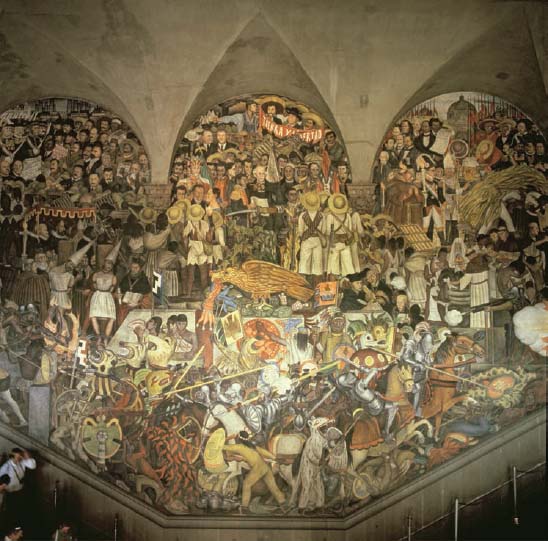The Modern World During and After the World Wars, C. 1914–1960Modern Art in Latin America |
Who was Diego Rivera? |
Diego Rivera (1886–1957) was an internationally renowned Mexican artist known for creating monumental public murals. Like Picasso, who he met while studying in Europe, Rivera was a child prodigy. During his early career, he went through a Synthetic Cubist phase; however, his mature style is characterized by large, figurative murals. Diego Rivera, along with other important Mexican artists such as José Clement Orozco and David Alfaro Siqueiros, aimed to create a new national art for Mexico. He studied frescoes in Italy and applied the technique to his murals, such as his series of Mexican history paintings at the Palacio Nacional (National Palace) in Mexico City, which blends European with Mayan and Aztec styles and features rich, bold colors and simplified forms. Rivera also completed murals in the United States, including his Depiction of Detroit Industry (1932–1933) at the Detroit Institute of Art. A vocal communist, Rivera’s politics sometimes caused criticism in America. While working on a commission from the Rockefeller family in New York, for example, Rivera planned to add a portrait of Russian leader Vladimir Lenin. The Rockefellers refused, paid Rivera’s fee, and destroyed his unfinished mural. Rivera ended up completing a different version of the mural, called Man, Controller of the Universe (1934) at the Museo del Palacio de Bellas Artes (Museum of Fine Art), which is one of Rivera’s most celebrated works.

Diego Rivera was an important modern artist who was part of the Mexican Muralist movement. Many of his works explore political themes and glorify Mexican heritage and history. Tribunal of the Inquisition is part of a fresco Rivera painted at the Palacio Nacional in Mexico City. (Art courtesy The Bridgeman Art Library, © 2013 Banco de Mexico Diego Rivera Frida Kahlo Museums Trust, Mexico, D.F. / Artists Rights Society [ARS], New York.)
